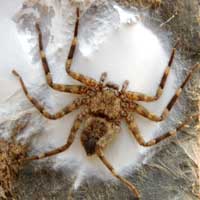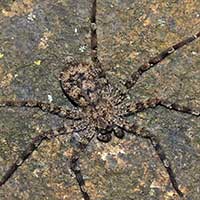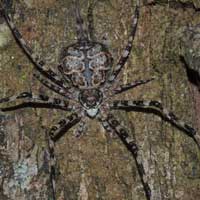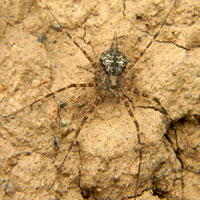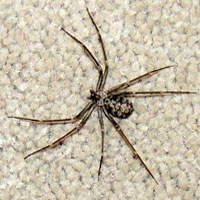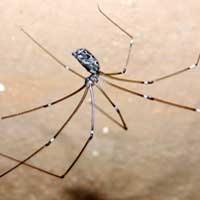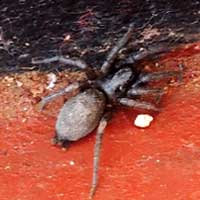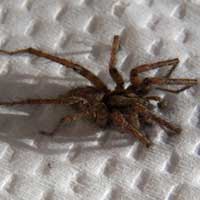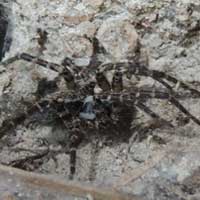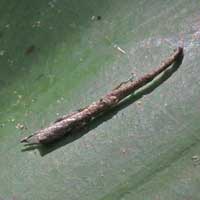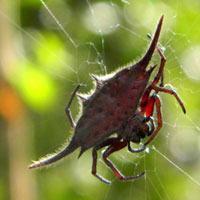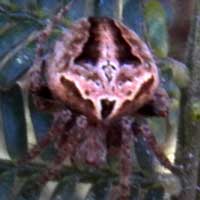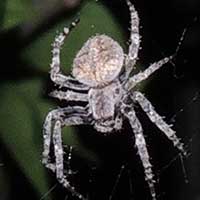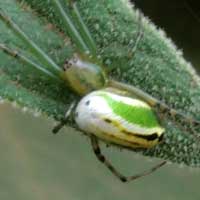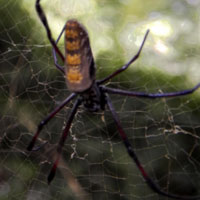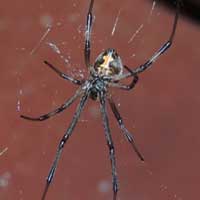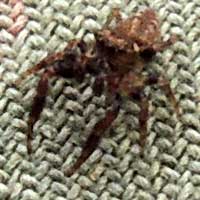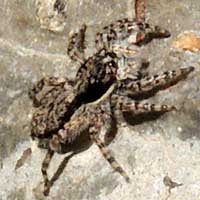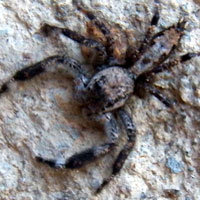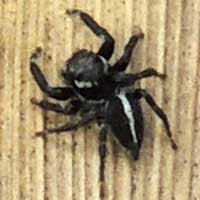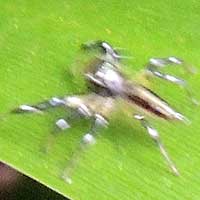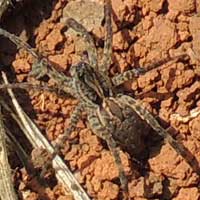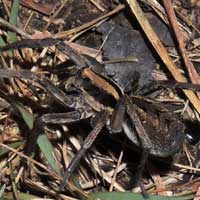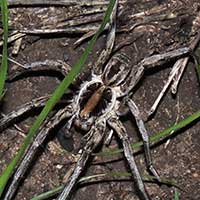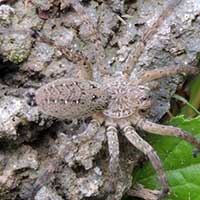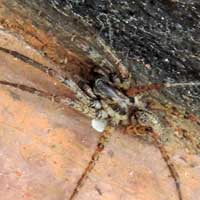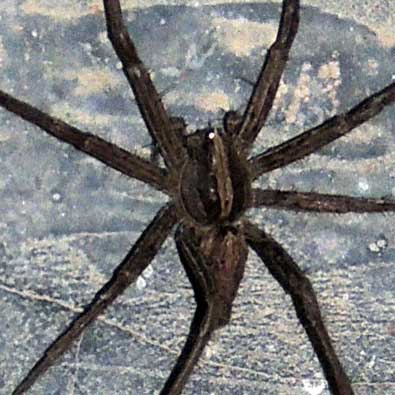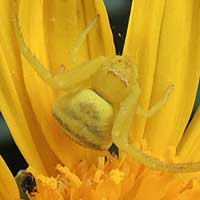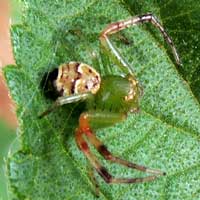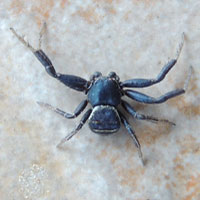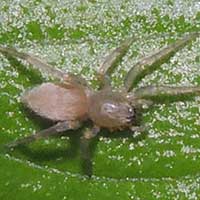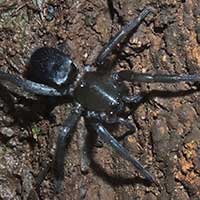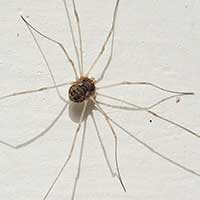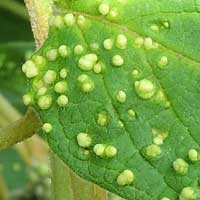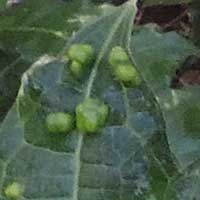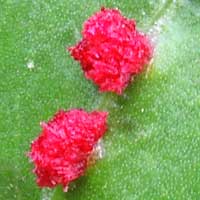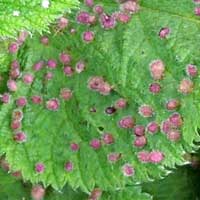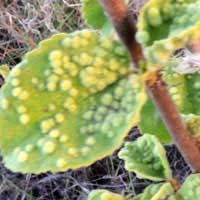Flat spiders hunt by night and are partial to climbing verticle surfaces. Hide under rocks or in crevices by day.
Another Flattie Spider, this one a male, apparently. Gray with intricate markings in darker gray.
Fine silk strands extend outward from the sitting spider. Anything that stumbles over them will triger an attack. Nocturnal.
A nearly invisible web directly against the substrate surrounds a spider that also blends in with camouflage. Two long spinneretes.
This spider makes a loose web in dark areas of building, caves. Violin mark on back. Long legs held flat on surface.
Very, very long legs on a spider that builds an irregular web in and near building or basements.
Large, dull black spiders that use retreats in cracks/gaps of walls in houses. Web appears very white due to fine, hackled threads. Not prone to bite people.
Uses a flat sheet web to capture insects and hides in a narrowed tunnel at one corner. Males leave webs in search of females. Eight small eyes.
The spider hides in a crevice with a large funnel web extending outwards. The bold black and white markings on this spider are unique.
This one does not even look alive ... it plays dead until the predator or disturbance moves on.
A colorful spider with conspicuous body armour. Sits at the center of an orb web erected between branches of vegetation.
Often hides during day but sits at center of an orb web at night. Many species. Head faces down in this photo.
Sits at center of circular orb web by night. Large, mostly uniform gray species.
By day this spider hides under a leaf where the green and white match the leaf.
Very large spiders that spin webs between trees or even across trails or high above a road. Silk very strong and yellow.
Dark brown spider with red hour-glass mark and an irregular web. Hides in crevice during the day.
Superb eyesight gives these active spiders abilities to travel and explore. This one's looking for a female.
This jumping spider was crawling on man-made concrete. Pattern is checkered blac and white.
Jumping Spiders do not use silk webs to catch prey. Instead they have superb eyesight and spring onto their prey and quickly deliver the bite.
This boldly marked salticid was hunting in the leaf litter of a farm plot.
Parts of this spider's marking are reflective and irridescent and might make it difficult to focus on.
Four big eyes towards the front of carapace. Runs across soil surface. Mostly nocturnal.
Slowly patrolling ground at night in a seasonally dry woodland without use of a web.
This large (18 mm) spider has whitish legs and markings that match sun-bleached stems of grass.
In areas with light-colored soil, cursorial ground-dwelling spiders also tend to be light-colored.
A cursorial spider about 12mm long. Narrow cephlothorax.
These large, fast, running spiders tend to live near water and can even skate across the surface.
Sitting on a flower of the same color the spider can ambush a visiting bee or fly. No snare is built.
Coloration often matches the plant part upon which it sits and waits for flower-visiting prey.
First two pair of legs are rotated forward and the spider tends to walk sideways like a crab. Hunts w/o a web.
Sac spiders spend the day inside a closely woven sac often within a folded leaf. Hunts at night w/o a web.
Ground spiders spend the day inside silken retreat on or near the ground. Spinnerets extend posteriorly. Hunts at night w/o a web.
These free ranging arachnids do not spin webs and are not venomous. Their super-long legs look improbable, yet this lineage has survived 400 million years.
Pale, raised blisters on the upper surface of leaves of Clerodendron shrubs. Mites live and feed inside the galls.
The galls on an Acanthus polystachyus leaf are likely caused by minute mites feeding and reproducing inside the plant tissue.
These mite galls are bright red partly because chlorophyl is not being produced in the tissue.
The mite galls on this Urtica leaf are purplish-brown. Stinging nettle has prickles tipped with painful neurotoxins.
The mite galls on this Hibiscus flavifolius leaf are pale green.
The arachnids that cause these leaf blisters are very small, requiring magnification. They live inside the blisters.
